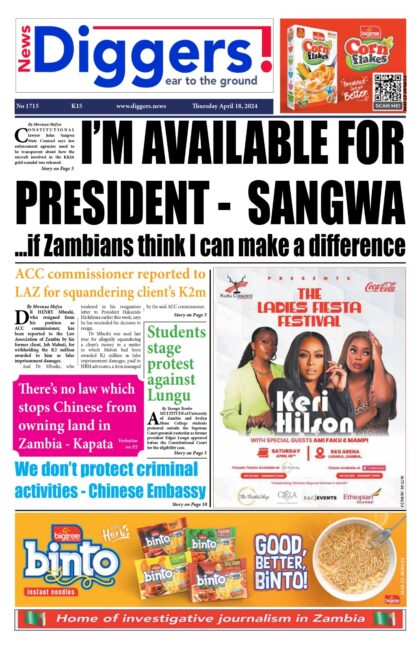The Zambia Chamber of Mines has called on government to maintain the same mining fiscal policy for continued stability and predictability.
And the Chamber has advised government to enhance indigenous ownership in the mining sector by adopting measures to encourage locals to invest in exploration.
Ahead of the 2019 national budget presentation tomorrow, Zambia Chamber of Mines president Nathan Chishimba advised government to maintain the mining fiscal policy to ensure stability and continued growth in the mining sector.
On February 17, 2016, Cabinet approved new mining tax measures that saw the re-designing of the tax regime for mining operations in a bid to sustain mining operations that were badly hit with a dramatic fall in copper prices, which were subdued at below US $5,000 per tonne in 2015.
Among the key measures was the introduction of a varied mineral royalty rate for copper based on the prevailing price on the international market, commonly referred to as the ‘sliding scale’; a flat mineral royalty rate of five per cent for other base metals and a flat mineral royalty of six per cent for precious metals and gemstones.
This followed the ill-fated 2015 mining fiscal regime, which had a two-tier regime characterised by a mineral royalty tax for open cast mines and underground operations.
Since those changes made a couple of years ago, the mining sector has enjoyed relative stability, buoyed by copper prices that remain above US $6,000 per tonne.
“The Zambia Chamber of Mines has reiterated its call for stability in mining policy. We are confident that stability in the fiscal and regulatory regime for mining, complimented with a few more non-cash actions, such as restoring working capital tied up in Value Added Tax refunds by offsetting against dues going forward, will go a long way in positioning the Zambian mining industry for double digit growth,” Chishimba stated in a press release issued in Lusaka, Wednesday.
“From current indications, Zambia can grow the sector to produce one million tons of copper per annum and then further upward to 1.5 million tonnes per annum, which is double the 1972 pre-nationalization production levels, within the next six years. With continued stability and a focus on growth, Zambia will easily attract exploration capital to extend the copper mining industry’s life beyond the twenty years of present proven bankable reserves of 20 million tonnes.”
He added that the mines also seek limits of capital allowance claims for equipment, among others.
“The other thing industry seeks is the removal of capping of carry forward loss tenure to ten years and the limiting to below 100 per cent of capital allowance claims for equipment and mine building expenditure in a year. This will shorten the break-even period for mining expansion and new projects, thereby, making the Copperbelt and North-Western provinces more attractive to mining company managers, institutional shareholders and financiers than it is presently,” Chishimba added.
And Chishimba, who is also Barrick Lumwana’s executive director, advised government to enhance local ownership in the mining sector by adopting measures to encourage Zambians to invest in exploration projects.
He stated that government should offer Zambians tax rebates when they buy shares in such projects.
“As a further means of enhancing Zambian ownership in the mining sector, we have also proposed that the State takes measures to encourage Zambians and Zambian institutions to invest in exploration by offering them tax rebates when they buy shares in such projects. We believe this will offer a bright future along the lines that our neighbour Botswana has enjoyed over their last 40 years of policy stability in their mining sector,” stated Chishimba.












